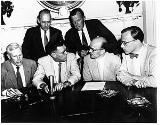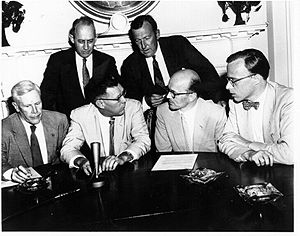
Alan Tower Waterman
Encyclopedia

United States
The United States of America is a federal constitutional republic comprising fifty states and a federal district...
physicist
Physicist
A physicist is a scientist who studies or practices physics. Physicists study a wide range of physical phenomena in many branches of physics spanning all length scales: from sub-atomic particles of which all ordinary matter is made to the behavior of the material Universe as a whole...
.
Born in Cornwall-on-Hudson, New York, he grew up in Northampton, Massachusetts
Northampton, Massachusetts
The city of Northampton is the county seat of Hampshire County, Massachusetts, United States. As of the 2010 census, the population of Northampton's central neighborhoods, was 28,549...
. His father was a professor of physics at Smith College
Smith College
Smith College is a private, independent women's liberal arts college located in Northampton, Massachusetts. It is the largest member of the Seven Sisters...
. Alan also became a physicist, doing his undergraduate and doctoral work at Princeton University
Princeton University
Princeton University is a private research university located in Princeton, New Jersey, United States. The school is one of the eight universities of the Ivy League, and is one of the nine Colonial Colleges founded before the American Revolution....
, from which he obtained his Ph.D. in 1916.
He joined the faculty of the University of Cincinnati
University of Cincinnati
The University of Cincinnati is a comprehensive public research university in Cincinnati, Ohio, and a part of the University System of Ohio....
, and married Mary Mallon (sister of H. Neil Mallon) there in August 1917. He later became a professor at Yale University
Yale University
Yale University is a private, Ivy League university located in New Haven, Connecticut, United States. Founded in 1701 in the Colony of Connecticut, the university is the third-oldest institution of higher education in the United States...
, and moved to North Haven, Connecticut
North Haven, Connecticut
North Haven is a town in New Haven County, Connecticut on the outskirts of New Haven, Connecticut.North Haven is less than ten miles from downtown New Haven and Yale University. It is near Sleeping Giant State Park and home the Quinnipiac University School of Health Sciences, the School of Nursing,...
in 1929. During World War II
World War II
World War II, or the Second World War , was a global conflict lasting from 1939 to 1945, involving most of the world's nations—including all of the great powers—eventually forming two opposing military alliances: the Allies and the Axis...
, he took leave of absence from Yale to become director of field operations for the Office of Scientific Research and Development
Office of Scientific Research and Development
The Office of Scientific Research and Development was an agency of the United States federal government created to coordinate scientific research for military purposes during World War II. Arrangements were made for its creation during May 1941, and it was created formally by on June 28, 1941...
, and the family moved to Cambridge, MA. He continued his government work and became deputy chief of the Office of Naval Research
Office of Naval Research
The Office of Naval Research , headquartered in Arlington, Virginia , is the office within the United States Department of the Navy that coordinates, executes, and promotes the science and technology programs of the U.S...
. In 1950, he was appointed as first director of the U.S.
United States
The United States of America is a federal constitutional republic comprising fifty states and a federal district...
National Science Foundation
National Science Foundation
The National Science Foundation is a United States government agency that supports fundamental research and education in all the non-medical fields of science and engineering. Its medical counterpart is the National Institutes of Health...
(NSF). Waterman was awarded the Public Welfare Medal
Public Welfare Medal
The Public Welfare Medal is awarded by the U.S. National Academy of Sciences "in recognition of distinguished contributions in the application of science to the public welfare." It is the most prestigious honor conferred by the Academy...
from the National Academy of Sciences
United States National Academy of Sciences
The National Academy of Sciences is a corporation in the United States whose members serve pro bono as "advisers to the nation on science, engineering, and medicine." As a national academy, new members of the organization are elected annually by current members, based on their distinguished and...
in 1960.
He served as director until 1963, when he retired and was subsequently awarded the Presidential Medal of Freedom
Presidential Medal of Freedom
The Presidential Medal of Freedom is an award bestowed by the President of the United States and is—along with thecomparable Congressional Gold Medal bestowed by an act of U.S. Congress—the highest civilian award in the United States...
. He died in 1967.
Alan and Mary had six children: Alan Jr., an atmospheric physicist, Neil, Barbara, Anne, Guy, the well-known climber, and Mary.
Besides his scientific talents, he was an accomplished musician and an avid outdoorsman, and eventually became a licensed Maine Guide
Maine Guide
This article is about wilderness guides. For the former minor-league baseball team, see Maine Guides.Maine Guides are individuals certified to accompany travelers on a number of outdoor activities in the wilderness of the State of Maine, in the United States.-History:On March 19, 1897, The Maine...
.
The crater Waterman
Waterman (crater)
Waterman is a lunar crater that is located on the Moon's far side, and cannot be viewed directly from the Earth. It lies along the southern outer ramparts of the prominent crater Tsiolkovskiy...
on the Moon
Moon
The Moon is Earth's only known natural satellite,There are a number of near-Earth asteroids including 3753 Cruithne that are co-orbital with Earth: their orbits bring them close to Earth for periods of time but then alter in the long term . These are quasi-satellites and not true moons. For more...
is named after him, as is Mount Waterman in the Hughes Range
Hughes Range (Antarctica)
The Hughes Range is a high massive north-south trending mountain range in Antarctica, surmounted by six prominent summits, of which Mount Kaplan is the highest...
of Antarctica.

